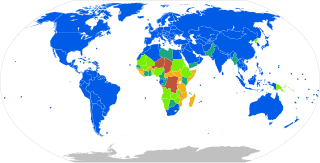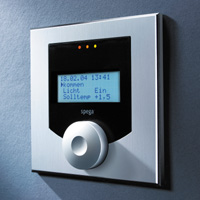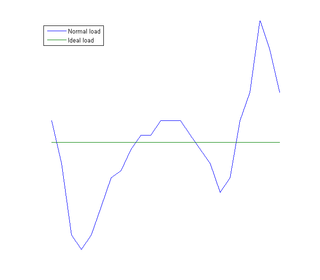
Mains electricity or utility power, power grid, domestic power, and wall power, or, in some parts of Canada, hydro, is a general-purpose alternating-current (AC) electric power supply. It is the form of electrical power that is delivered to homes and businesses through the electrical grid in many parts of the world. People use this electricity to power everyday items by plugging them into a wall outlet.

Home automation or domotics is building automation for a home. A home automation system will monitor and/or control home attributes such as lighting, climate, entertainment systems, and appliances. It may also include home security such as access control and alarm systems.

Power-line communication, abbreviated as PLC, carries data on a conductor that is also used simultaneously for AC electric power transmission or electric power distribution to consumers.

Automatic meter reading (AMR) is the technology of automatically collecting consumption, diagnostic, and status data from water meter or energy metering devices and transferring that data to a central database for billing, troubleshooting, and analyzing. This technology mainly saves utility providers the expense of periodic trips to each physical location to read a meter. Another advantage is that billing can be based on near real-time consumption rather than on estimates based on past or predicted consumption. This timely information coupled with analysis can help both utility providers and customers better control the use and production of electric energy, gas usage, or water consumption.
Broadband over power lines (BPL) is a method of power-line communication (PLC) that allows relatively high-speed digital data transmission over public electric power distribution wiring. BPL uses higher frequencies, a wider frequency range, and different technologies compared to other forms of power-line communications to provide high-rate communication over longer distances. BPL uses frequencies that are part of the radio spectrum allocated to over-the-air communication services; therefore, the prevention of interference to, and from, these services is a very important factor in designing BPL systems.
HomePlug is the family name for various power line communications specifications under the HomePlug designation, each with unique capabilities and compatibility with other HomePlug specifications.

An electricity meter, electric meter, electrical meter, energy meter, or kilowatt-hour meter is a device that measures the amount of electric energy consumed by a residence, a business, or an electrically powered device.
IEEE 1901 is a standard for high-speed communication devices via electric power lines, often called broadband over power lines (BPL). The standard uses transmission frequencies below 100 MHz. This standard is usable by all classes of BPL devices, including BPL devices used for the connection to Internet access services as well as BPL devices used within buildings for local area networks, smart energy applications, transportation platforms (vehicle), and other data distribution applications.

A smart meter is an electronic device that records information—such as consumption of electric energy, voltage levels, current, and power factor—and communicates the information to the consumer and electricity suppliers. Such an advanced metering infrastructure (AMI) differs from automatic meter reading (AMR) in that it enables two-way communication between the meter and the supplier.
Dynamic Demand is the name of a semi-passive technology to support demand response by adjusting the load demand on an electrical power grid. It is also the name of an independent not-for-profit organization in the UK supported by a charitable grant from the Esmée Fairbairn Foundation, dedicated to promoting this technology. The concept is that by monitoring the frequency of the power grid, as well as their own controls, intermittent domestic and industrial loads switch themselves on/off at optimal moments to balance the overall grid load with generation, reducing critical power mismatches. As this switching would only advance or delay the appliance operating cycle by a few seconds, it would be unnoticeable to the end user. This is the foundation of dynamic demand control. In the United States, in 1982, a (now-lapsed) patent for this idea was issued to power systems engineer Fred Schweppe. Other patents have been issued based on this idea.

Load management, also known as demand-side management (DSM), is the process of balancing the supply of electricity on the network with the electrical load by adjusting or controlling the load rather than the power station output. This can be achieved by direct intervention of the utility in real time, by the use of frequency sensitive relays triggering the circuit breakers, by time clocks, or by using special tariffs to influence consumer behavior. Load management allows utilities to reduce demand for electricity during peak usage times, which can, in turn, reduce costs by eliminating the need for peaking power plants. In addition, some peaking power plants can take more than an hour to bring on-line which makes load management even more critical should a plant go off-line unexpectedly for example. Load management can also help reduce harmful emissions, since peaking plants or backup generators are often dirtier and less efficient than base load power plants. New load-management technologies are constantly under development — both by private industry and public entities.

The smart grid is an enhancement of the 20th century electrical grid, using two-way communications and distributed so-called intelligent devices. Two-way flows of electricity and information could improve the delivery network. Research is mainly focused on three systems of a smart grid – the infrastructure system, the management system, and the protection system. Electronic power conditioning and control of the production and distribution of electricity are important aspects of the smart grid.
Gigabit Home Networking (G.hn) is a specification for wired home networking that supports speeds up to 2 Gbit/s and operates over four types of legacy wires: telephone wiring, coaxial cables, power lines and plastic optical fiber. Some benefits of a multi-wire standard are lower equipment development costs and lower deployment costs for service providers.

An electrical grid is an interconnected network for electricity delivery from producers to consumers. Electrical grids consist of power stations, electrical substations to step voltage up or down, electric power transmission to carry power long distances, and lastly electric power distribution to individual customers, where voltage is stepped down again to the required service voltage(s). Electrical grids vary in size and can cover whole countries or continents. From small to large there are microgrids, wide area synchronous grids, and super grids.
IEEE 2030 was a project of the standards association of the Institute of Electrical and Electronics Engineers (IEEE) that developed a "Guide for Smart Grid Interoperability of Energy Technology and Information Technology Operation with the Electric Power System (EPS), and End-Use Applications and Loads".
Smart grid policy in the United States refers to legislation and other governmental orders influencing the development of smart grids in the United States.
The Open Smart Grid Protocol (OSGP) is a family of specifications published by the European Telecommunications Standards Institute (ETSI) used in conjunction with the ISO/IEC 14908 control networking standard for smart grid applications. OSGP is optimized to provide reliable and efficient delivery of command and control information for smart meters, direct load control modules, solar panels, gateways, and other smart grid devices. With over 5 million OSGP based smart meters and devices deployed worldwide it is one of the most widely used smart meter and smart grid device networking standards.
The UCLA Smart Grid Energy Research Center (SMERC), located on the University of California Los Angeles (UCLA) campus, is an organization focused on developing the next generation of technologies and innovation for Smart Grid. SMERC partners with government agencies, technology providers, Department of Energy (DOE) research labs, universities, utilities, policymakers, electric vehicle manufacturers, and appliance manufacturers. These partnerships provide SMERC with diverse capabilities and exceptional, mature leadership.
A Distribution Transformer Monitor (DTM) is a specialized hardware device that collects and measures information relative to electricity passing into and through a distribution transformer. The DTM is typically retrofitted onto pole top and pad mount transformers. A pole top or pad mount transformer commonly powers anywhere from 5-8 homes in the US and is the last voltage transition in stepping down voltage before it gets to the home or business. The conventional placement of Distributed Temperature Monitoring (DTM) devices is typically observed at the terminals of transformers. However, there are instances where these devices are directly affixed to the secondary power lines. DTM apparatus commonly comprises precision-centric sensors, either of the non-piercing or piercing variety, in addition to communication modules integrated on board for seamless data transmission. Adequate provisions for power supply are also incorporated within the DTM setup. The captured data from the DTM unit is relayed to a central data collection engine and/or the established Supervisory Control and Data Acquisition (SCADA) / Meter Data Management (MDM) system, where pertinent information pertaining to the transformer is stored and made accessible to users. Often, analytical platforms come into play to decipher the data gleaned and reported by the DTM, thereby enhancing the comprehension of the acquired information.
Transactive energy refers to the economic and control techniques used to manage the flow or exchange of energy within an existing electric power system in regards to economic and market based standard values of energy. It is a concept that is used in an effort to improve the efficiency and reliability of the power system, pointing towards a more intelligent and interactive future for the energy industry.








